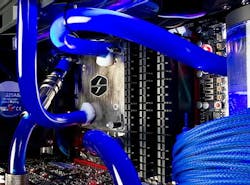IARPA asks industry for power-efficient cables to move fast data from cryogenic to room temperature
Officials of the Intelligence Advanced Research Projects Agency (IARPA) in Washington issued a draft broad agency announcement on Tuesday (IARPA-BAA-18-02) for the SuperCables project.
The IARPA SuperCables program, expected to begin in July 2018, seeks to develop energy-efficient, fast data transmission of digital signals between computing systems operating at room and a cryogenic temperature of 4 Kelvin, which is minus 269 Celsius.
Many of today's high-performance supercomputers must operate at cryogenic temperatures to avoid overheating. The problem is moving supercomputer data to computer banks operating at room temperature for further data analysis.
This conversion process from one temperature zone to another can be exceedingly power-hungry, and the program's goal is to develop cables to move data from cryogenic temperatures to room temperatures without busting the power budget. IARPA is the research arm of the U.S. Director of National Intelligence.
Related: Article headline goes here
The SuperCables program seeks to demonstrate components to convert from low-level electrical signals in circuits operating at 4 degrees Kelvin to conventional optical signals at room temperature. If results are promising, IARPA may support a follow-on program to develop a complete system.
Computing at cryogenic temperatures may use digital or analog electrical signals, but ultimately must communicate with optical fiber networks operating at room temperature, IARPA officials explain.
A key consideration, however, is the high level of electrical power necessary to do this. IARPA researchers want to make sure that electricity demand for data transfer and system cooling does not dominate total system power demand.
Conventional systems for data transmission between room and cryogenic temperatures communicate using electrical signals; any conversion between optical and electrical signals happens at room temperature, researchers say.
The downside, however, is the potential for leaking heat down the electrical conductors, as well as the power and cooling necessary to amplify electrical signals for transmission to room temperature.
Related: Rugged fiber optic cable for commercial aircraft networking and displays introduced by OFS
For low data rates, power demand is manageable, but not so for many computing applications that require fast data communication with networks or other computers.
IARPA researchers want improved communication systems between cryogenic and room temperature environments that can to much higher data rates without prohibitive power budgets. Doing also could greatly increase the application space for data-intensive and streaming applications.
The goal of the SuperCables program is to develop components for the data egress system. A follow-on project may address data ingress or system integration. The program now will address only the subsystem managing electrical to optical signal conversion and transmission from cryogenic to room temperature.
IARPA researchers want industry to develop a device to convert digital electronic information at 4 Kelvin into digital optical information. A cryogenic testbed will be provided.
Companies interested should email responses to IARPA at [email protected] no later than 17 Nov. 2017. More information is online at https://www.fbo.gov/notices/2f25249dcb9abaab8e3136ce4fc08c09.
Ready to make a purchase? Search the Military & Aerospace Electronics Buyer's Guide for companies, new products, press releases, and videos
